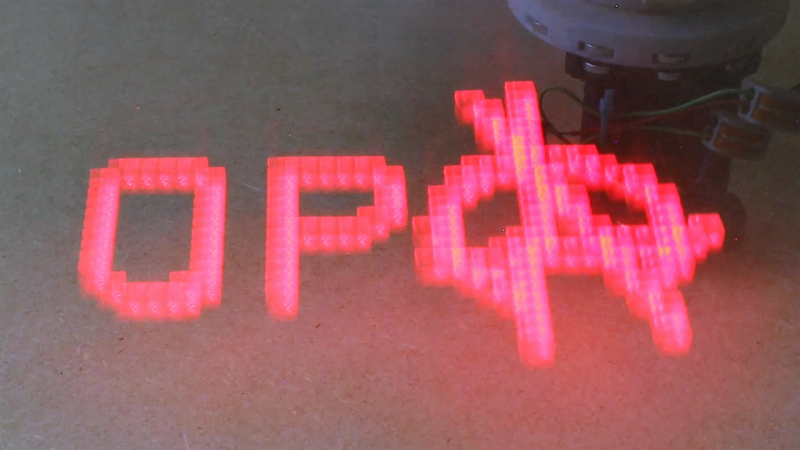Most photographs are made in the fraction of a second that the camera’s shutter is gathering reflected light from the scene. But there’s fun to be had by leaving the shutter open and directing light into the camera. Called light painting, it can be as simple as a camera on a tripod in a dark room and a penlight spelling out dirty words – not like we’d know – or as complicated as this CNC dot-matrix light printer.
The first idea that [Jeremy S. Cook] had for this build didn’t go so well. He fitted an LED to the gantry of his 3D-printer, intending to send it G-code representing bitmaps. The idea would be to set it up in a dark place, open the shutter, and let the machine build up the image by rastering through the X- and Y- axes while blinking the LED on and off at the right time. But since the gantry only moves in one axis, he abandoned the printer in favor of his CNC router. He printed a collar to fit the dust collector shroud we previously featured, added a battery-powered LED, and affixed a pushbutton switch to the let the Z-axis turn on the light. It took some tweaking such as adding a translucent PLA diffuser, to get decent images, but in the end it worked. We like the soft look of the floating voxels, which were really helped by the later addition of a Nano and a Neopixel. Check out the build in the video below.
One thing we’d suggest is better reflection control. [Jeremy] used a black platen as a background, but it wasn’t quite enough. We suggest going none more black next time.
















OPA? Pff… inner planets rule you.
You’re right :-(
Thanks for the writeup! Had not heard of that (and other) ultra-black paints. I’ll have to keep that in the back of my mind.
That saturated white stuff keeps getting in to the pretty colors. HDR mode should get rid of it, it’s in most phones now. I don’t know how it would integrate with time lapse, but under exposure would be better anyway. The white centers of the cubes spoil the colorful effect.
In the beginning definitely. Same thoughts about the pics toward the end of the video?
Camera shutters don’t gather light any more than the photographer’s hair does.
For the 3D printer: put the camera where the hot end would go, and the LED (or LEDs) on the sled?
Would perhaps work, though I’d have a tough time fitting my camera there! Using the Z and X axes would be another alternative, though one would have to figure out how to trigger the light.
There are cameras and then there are cameras. I was thinking of a funny little point-n-shoot. For a DSLR, you probably need the big CNC. Smoke ’em if you got ’em. :)
Related/non-related: I recently learned that when doing “star trails” photos, folks get around the background noise problem that digital sensors have by compositing multiple 30s exposures.
It’s kinda cheating in a light-painting context, but this made me think of that, and there you go.
https://www.popularmechanics.com/space/a25697/beginners-guide-to-astrophotography/